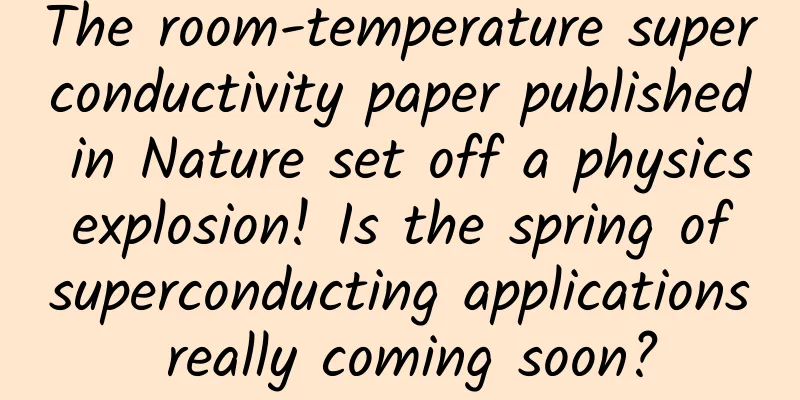The room-temperature superconductivity paper published in Nature set off a physics explosion! Is the spring of superconducting applications really coming soon?

|
The road to finding superconducting materials suitable for the civilian market is long and arduous. From superconducting generators that can carry a large amount of electricity but produce almost no additional energy consumption, superconducting DC transmission lines, to signal communication base stations with wider signal coverage and stronger anti-interference capabilities... In the step-by-step exploration, superconducting technology is waiting for the next spring. Written by reporter Wang Xueying, Photo and text editor by Ji Jingjing Interview experts: Li Tao (Professor of Physics Department, Renmin University of China) On March 8, at the annual meeting of the American Physical Society, Professor Ranga Dias of the University of Rochester announced that the team had achieved room-temperature superconductivity of 294K (Kelvin), about 21°C above zero, in a lutetium-nitrogen-hydrogen system material under a pressure of 1GPa (about 10,000 atmospheres). The relevant paper was officially published in the journal Nature in the early morning of March 9. This news first made physicists around the world uneasy - according to the pictures and reports sent back from the conference site that day, as soon as the news was released, the large number of physics bigwigs who had gathered outside the venue immediately became agitated, and security personnel had to prevent more people from entering in advance. ▲The American Physical Society held in Las Vegas (Photo from the Internet) Secondly, the news also alarmed the A-share market. Some securities firms held an expert meeting late at night on March 8, and investors studied "room-temperature superconductivity" overnight. #Room-temperature superconductivity, an academic term in a professional field, has not only swept the major social platforms, but even friends in the circle of friends who usually only care about running and health have followed up and asked questions: "What exactly is room-temperature superconductivity? What does it have to do with us?" What is a superconductor? Before answering the question "What is room-temperature superconductivity", we first need to talk about the concept of "superconductor". Superconductivity is a phenomenon in which the resistance of a material becomes zero when the temperature is below a certain level. As the name suggests, a superconductor is an object that can conduct electricity at a high rate. As we all know, according to the different conductivity properties, materials can be roughly divided into conductors, semiconductors and insulators. Metal materials such as iron and aluminum are conductors, with low current resistance. There are a large number of freely movable charged particles in them. These electrons can "walk freely" under the action of an external electric field, forming a significant current. Because of this, conductors are easy to conduct electricity; on the contrary, insulators such as rubber and plastic have extremely high resistance, and charged particles are "trapped" around atoms and cannot "move freely", so they are not easy to conduct electricity. As for semiconductors such as silicon, germanium, and gallium arsenide, they are materials with properties between the first two. According to Joule's law, no matter how good the conductivity of a conductor is, resistance will generate Joule heat, which will cause additional energy consumption. In theory, if you want the current to be transmitted without energy loss, the resistance must be zero, and superconductors are such an ideal material. At a certain temperature, its resistance can become 0, and the loss when transmitting current is also 0. Not only will it not generate heat, but no voltage is required at both ends of the wire. In addition to zero resistance and zero loss, the completely anti-magnetic properties of superconductors are also very attractive. Simply put, if we place a magnet directly below a superconductor, when the magnet generates a magnetic field, the superconductor will generate an opposite magnetic field due to the absolute repulsion of the magnetic field inside, and thus repel the magnet. If this repulsive force and the gravity of the superconductor can be balanced, then the superconductor can be suspended. ▲Superconductors suspended in the air due to their completely antimagnetic properties (Source: Quanta) By using the properties of superconductors, people can use them to "lift" heavy and huge carriages, such as the MLX series of low-temperature superconducting maglev train test lines on the JR line in Japan. They can also be used to monitor gravity changes, observe tides, detect earthquakes, etc., such as the maglev gravimeters commonly used in astronomical and geographical research. As for the "Josephson effect" of superconductors, if an insulating layer is sandwiched between two superconductors, when the thickness of the insulating layer is close to that of an atom, electrons can directly pass through the insulating layer, generating a tunnel current phenomenon. Using this property, people can not only make faster superconducting computers that consume less energy to run, but also make superconducting quantum interferometers with higher sensitivity and less noise. In other words, if there really is a superconducting material that can be used commercially on a large scale, it will be a major change that will affect many fields. Stuck Temperature However, the reason why superconductors are considered ideal materials is that they are really hard to find. So far, the application of superconductors is still mainly in specific experimental scenarios such as particle accelerators and superconducting quantum interference devices, and the main reason limiting their large-scale commercial use is temperature. In physics, the temperature at which a superconducting material enters the superconducting state is called the superconducting critical temperature. In 1911, scientists at Leiden University in the Netherlands discovered that the resistance of metallic mercury suddenly disappeared below 4.2K, which was the first superconducting phenomenon discovered by humans. In the following hundred years, humans have discovered various superconducting materials, such as alloys, intermetallic compounds and even organic compounds. However, scientists were delighted to find that the critical temperature for maintaining the superconducting properties of these materials is generally very demanding, basically below 50K (about -220℃), and it is almost impossible to achieve without liquid nitrogen or liquid helium. For this reason, high pressure has become the main way to increase the critical temperature of superconductivity. Imagine if a material can only work properly at a temperature of several hundred degrees below zero or at an extremely high pressure of more than 100GPa, how likely is it to apply this technology to the market on a large scale? Remember, the pressure at the center of the earth is only 370GPa! Either relying on extreme refrigeration conditions or relying on terrible high pressure means, is there no material that can maintain superconducting properties at room temperature (300K, about 27°C)? The road to finding room-temperature superconductors is undoubtedly long. For a long time, researchers believed that the superconducting transition temperature could not exceed 30K. In 1986, the discovery of copper oxide high-temperature superconductors opened the way for human exploration of high-temperature superconducting materials. Copper oxide high-temperature superconductors are not only the first superconductors with a transition temperature exceeding the boiling point of liquid nitrogen (the boiling point of liquid nitrogen is 77K, about -196℃, and a transition temperature higher than the boiling point of liquid nitrogen provides very convenient conditions for the commercial application of superconductors), but it is also generally believed that the superconducting mechanism of copper oxide high-temperature superconductors exceeds the description scope of the traditional electron-phonon BCS theory, which provides a broad imagination space for exploring superconductors with better performance. In 2015, the Max Planck Institute for Chemistry in Germany discovered that hydrogen sulfide compounds exhibit superconductivity at a temperature of around -70°C under 150GPa. Four years later, the research team further discovered that lanthanum decahydride only needs -23°C to enter the superconducting state under high pressure conditions... There is no doubt that thanks to the unremitting efforts of many scientists, the superconducting critical temperature of new materials is constantly being refreshed, but even so, it still cannot get rid of the premise of ultra-high pressure which lacks practical application scenarios. For a time, human research on room-temperature superconductivity seemed to have reached a bottleneck. ▲In the 2020 study, the University of Rochester used a special diamond anvil, which is mainly composed of two "point-to-point" diamonds. (Photo source: University of Rochester) In 2020, Ranga Dias' team at the University of Rochester said that they tried to mix carbon, sulfur, and hydrogen, and used laser irradiation and diamond anvils to successfully make the material enter a superconducting state at room temperature of about 15°C (287.7K). Although the experiment still requires high pressure conditions - the compression of the diamond anvil provides a high pressure of 267GPa, the critical temperature close to room temperature in this study still made a sensation around the world. The international authoritative journal Nature even published a cover issue to celebrate it... Overnight, the beautiful wish of mankind to achieve room temperature superconductivity seems to be within reach. However, people's excitement did not last long, and doubts from the industry began to emerge. Many academic leaders questioned the data: "According to previous theories, experiments in recent years have brought the superconducting critical temperature very close to room temperature, and even much higher than room temperature, but it has not received widespread attention or been officially published." Some experimental physicists said that Ranga Dias' "paper data is too beautiful, the transition to zero resistance of superconductivity is very steep, and there are a series of problems with the related results." Some theoretical physicists even bluntly stated that the "data results of his research are contrary to basic physics." Finally, amid huge controversy, despite strong opposition from nine authors including Ranga Dias, Nature magazine decided to retract the paper in September 2022. How far are we from superconducting materials at room temperature and pressure? If the research of Ranga Dias' team can be verified, it will be a milestone in the research of room-temperature superconductivity. Although the gas pressure of 1GPa is still very high, equivalent to 10,000 times the atmospheric pressure, it has been greatly reduced compared with the gas pressure used to achieve room-temperature superconductivity in the past. However, affected by the previous "retraction storm", the journal stated that it would conduct "stricter review" of the research results. At the same time, Dias' paper published a lot of experimental data and videos. These experimental conditions are not difficult to repeat, and "the results will soon be known." In an interview with the media, Sun Liling, a researcher at the Institute of Physics of the Chinese Academy of Sciences, said that people expect this to be verified by more experimental research groups, but the research results need to be scrutinized. "It is worth noting that the color of the sample photo given in the Dias report is blue, which is completely different from the black and brown colors of superconductors we usually see. If its color is the true color of the sample, it means that even if other research groups can experimentally confirm its superconductivity in the future, this superconductor should not be the superconductor we have known before," she said. ▲A screenshot of the experimental video given in Dias’ latest paper, in which the sample is blue under ambient pressure. Li Tao, a professor at the Department of Physics of Renmin University of China, expressed a relatively positive view on this. "I personally think that if it is confirmed, the significance of this discovery is very great." Li Tao told reporters that although the superconducting mechanism of this system may still be the traditional electron-phonon BCS mechanism, this discovery will undoubtedly prompt us to think about where the boundary of the application range of this traditional superconducting theory is, especially it will provide important inspiration for exploring superconductors that break through the so-called 'McMillan limit' (physicist McMillan once inferred from the electron-phonon BCS theory that there is an upper limit to the critical temperature of superconductors. It is generally believed that the current critical temperature record of electron-phonon mechanism superconductors under normal pressure is 39K achieved in MgB2, about -234℃). He said: "Although the critical temperature of superconductors is not the only factor restricting their application, if this discovery is confirmed, at least we can learn how to create conditions to increase the critical temperature under normal pressure conditions." Luo Huiqian, a researcher at the Institute of Physics, Chinese Academy of Sciences, believes that based on the current high-pressure synthesis measurement technology, the sample yield is very low and it is not necessarily stable under normal pressure, so room-temperature superconductivity is unlikely to have large-scale applications. However, if superconducting materials can be synthesized without high pressure in the future, even if the temperature is not really at room temperature, it will have a wide range of uses at temperatures close to room temperature. In fact, despite new discoveries from time to time, overall, the global superconducting material research has been in an embarrassing bottleneck period in the past decade. The reason is that "marketization" may be the most difficult obstacle to overcome - how to apply new discoveries in the laboratory to the commercial market that emphasizes cost, efficiency and limited production conditions? This question seems difficult to answer. "Although laboratories have gradually found some new materials with higher critical temperatures, these new materials have never been able to enter the commercial market and have no way to be put into practical use due to factors such as price and performance," said an industry insider who declined to be named. Nowadays, superconducting technology is still very mysterious to most ordinary people, and even often causes "misunderstandings": when it comes to superconducting technology, people always think of maglev trains, but in fact, most maglev trains in real life use conventional conductors, such as the maglev trains in Germany and Shanghai, which have little to do with superconducting technology. In contrast, it is the magnetic resonance imaging (MRI) used in hospitals, especially MRI above 1.5T, which is the superconducting technology closest to ordinary people. Compared with CT imaging and other technologies, MRI not only has no radiation, but also can provide doctors with richer and clearer contrast images, especially for different soft tissues such as the brain and spinal cord or the central nervous system. Today, 9.4T ultra-high field MRI can not only help humans check diabetes and heart disease in theory, but also help detect Alzheimer's disease at an early stage, providing better technical support for humans to solve the "difficult to treat but only preventable" diseases. It is not easy to find superconducting materials suitable for the civilian market. Although the road is long and arduous, humans have never stopped looking for superconducting materials. From superconducting generators that can carry a large amount of electricity but produce almost no additional energy consumption, superconducting DC transmission lines, to signal communication base stations with wider signal coverage and stronger anti-interference ability... In the step-by-step exploration, superconducting technology is waiting for the next spring. Produced by: Science Central Kitchen Produced by: Beijing Science and Technology News | Beijing Science and Technology Media Reproduction without authorization is prohibited, and offenders will be prosecuted |
<<: Shocked! H1N1 flu can also cause white lungs! These groups should not be careless
>>: First full-brain map of insects completed
Recommend
More than 70% of netizens keep their phones in their hands every day. Be careful of contracting "mobile phone disease"
As more and more people realize the dangers of &q...
AARRR model case: How to use data to optimize channel delivery?
With the disappearance of the new population divi...
Parasites that cats avoid may be transformed into medical weapons by scientists
When we talk about Toxoplasma, we tend to think o...
LeEco's ecological dream was dismembered by capital. Where is Jia Yueting's poetry and distant future?
Jack Ma once said, "You have to have dreams,...
People with high blood pressure or cardiovascular disease, as well as the elderly, please take note! It is really not a hassle to have your heart checked.
People who are most concerned about annual physic...
How to avoid pitfalls when promoting on Xiaohongshu? Xiaohongshu marketing promotion guide!
At present, the hottest brand marketing and promo...
New App Promotion Techniques: Video Promotion Makes Your App Popular Overnight
Everyone on the Internet is familiar with Chai Ji...
Medical and health institutions have achieved full coverage of counties, towns and villages! How is it achieved specifically? Details attached!
On May 24, 2022, the National Health Commission h...
36 Sales Strategies, Sales Skills That Never Go Out of Style
Mr. Bao once worked for a Fortune 500 company, st...
Tianjin’s new fishing ban regulations 2022: From which specific months is the fishing ban period?
In order to protect the fish in the rivers, my co...
If you turn on WiFi, your phone will be attacked fatally?
In the early hours of this morning Beijing time, ...
Kotlin has become the new darling of Android after waking up [with code]
Preface Did you watch the live broadcast of Googl...
Mysterious respiratory disease is spreading among American dogs; eating nuts can improve men's sperm quality | Technology Weekly
Compiled by Zhou Shuyi Mysterious respiratory dis...
Souwai Elite Sharing Class Video Course 618 Promotion!
Souwai 618 video course: From 0 to 1 Baidu SEM bi...
User churn data analysis tips!
A classmate asked: How to analyze user churn? The...









